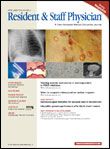Dermatology
Prepared by Aurelio Torres, MD, Resident, Department of Medicine, Saint John?s Episcopal Hospital, Far Rockaway, NY, and Ioshvanni Miguel, MD, Resident, Department of Medicine, Flushing Medical Center, Flushing, NY
An 80-year-old woman presented to the hospital because of a more than 1-week history of sore throat associated with odinophagia and itchy lesions on her chest, arms, and thighs. Physical examination revealed many 1- to 4-cm, eroded, crusted, and healed lesions on her arms (Figure 1). These lesions had first manifested like the tense, clear vesicles that were observed on her chest and thighs (Figure 2). There were also some lesions on her palate and buccal mucosa. Nikolsky?s sign was negative. The patient had not taken any medication recently and reported no gastrointestinal symptoms or other oral lesions.
WHAT'S YOUR DIAGNOSIS?
- Immunoglobulin A bullous pemphigus
- Erythema multiforme
- Bullous pemphigoid
- Pemphigus vulgaris
Quiz Answer
Bullous pemphigoid (BP)—BP is a chronic, autoimmune, subepidermal, blistering skin disease that is predominantly observed in the elderly. This disease is characterized by an immunoglobulin G (IgG) autoimmune response directed against the hemidesmosome antigens BP230 (BPAg1) and BP180 (BPAg2).1 When the IgG autoantibodies attach to the skin basement membrane, they trigger complement and inflammatory mediators. As inflammatory cells migrate to the basement membrane, they are thought to release proteases, which break down hemidesmosome proteins and cause blisters. These blisters are tense; tend to be distributed symmetrically; range from 1 to 4 cm in diameter; and are filled with clear fluid (Figure). They may persist for several days, after which they leave eroded and crusted areas, as observed in our patient.
Figure 3—Photograph showing blisters characteristic of BP.
BP has been associated with the use of systemic medications, such as furosemide (Lasix, Lo-Aqua), phenytoin (Dilantin), amoxicillin (eg, Amoxicot, Amoxil), ciprofloxacin (eg, Cipro, Ciproxin), and captopril (Capoten). Diagnosis relies on detecting autoantibodies bound to the skin or circulating in the serum by direct and indirect immunofluorescence microscopy, enzyme-linked immunosorbent assay, or immunoblot techniques.2 Circulating antibasement membrane IgG antibodies are detected in 60% to 80% of patients.3 Systemic immunosuppressive agents, particularly oral corticosteroids, are the gold standard for treating BP.3
Linear immunoglobulin A (IgA) bullous dermatosis results when there is a linear deposition of IgA along the cutaneous basement membrane that results in immune-mediated, subepidermal, vesiculobullous eruptions. This disease occurs in children and in adults. IgA bullous dermatosis can be clinically variable, mimicking dermatitis herpetiform or bullous pemphigoid. Direct immunoelectrophoresis will demonstrate linear IgA deposition along the cutaneous basement membrane. Most patients are successfully treated with sulfapyridine (Dagenan) or dapsone therapy; occasionally, prednisone (eg, Meticorten, Sterapred) must be added.4
Erythema multiforme is an acute, self-limited skin disease that is usually caused by the herpes virus. It is characterized by round, red, cutaneous lesions that erupt quickly, generally appearing within 24 hours. These lesions usually remain unchanged for 7 days or more and then evolve into "target" lesions. Target lesions are characterized by concentric zones of color change. They have a central dusky or purple zone and an outer red zone. Diagnosis is based on the patient's physical examination. The goal of treatment is to control the patient's symptoms and prevent secondary infections. Some treatments may include moist compresses, antihistamines, or systemic corticosteroids for more severe cases.
Pemphigus vulgaris is characterized by painful blisters of the oral mucosa and skin. The skin lesions are flaccid and thin-walled and easily rupture, forming painful erosions that ooze and bleed. These erosions become generalized and crusted, and they heal poorly. Nikolsky's sign is positive, meaning slight pressure or rubbing will cause superficial layers of the skin to slough off, leaving a raw, red base. The characteristic histologic finding is acantholysis (intraepidermal blister). Diagnosis is made when IgG autoantibodies directed against the cell surface of keratinocytes are identified. Direct immunofluorescence is the most reliable and sensitive diagnostic test. The therapeutic goal is to control the disease with the lowest possible dose of corticosteroids. Plasmapheresis and high-dose intravenous immunoglobulin are therapeutic options for disease that is refractory to treatment.
References
- Chan L. Bullous pemphigoid. Available at: www.emedicine.com. Accessed April 1, 2008.
- Goebeler M, Zillikens D. Bullous pemphigoid: diagnosis and management. Expert Review of Dermatology. 2006;1:401-411.
- Borradori L, Bernard P. Pemphigoid group. In: Bolognia JL, Jorizzo JL, Rapini RP, eds. Dermatology. London, England: Mosby;2003: 313-508.
- Klein PA, Hall R. Linear IgA dermatosis. Available at: www.emedicine.com. Accessed April 1, 2008.
Read the answer
